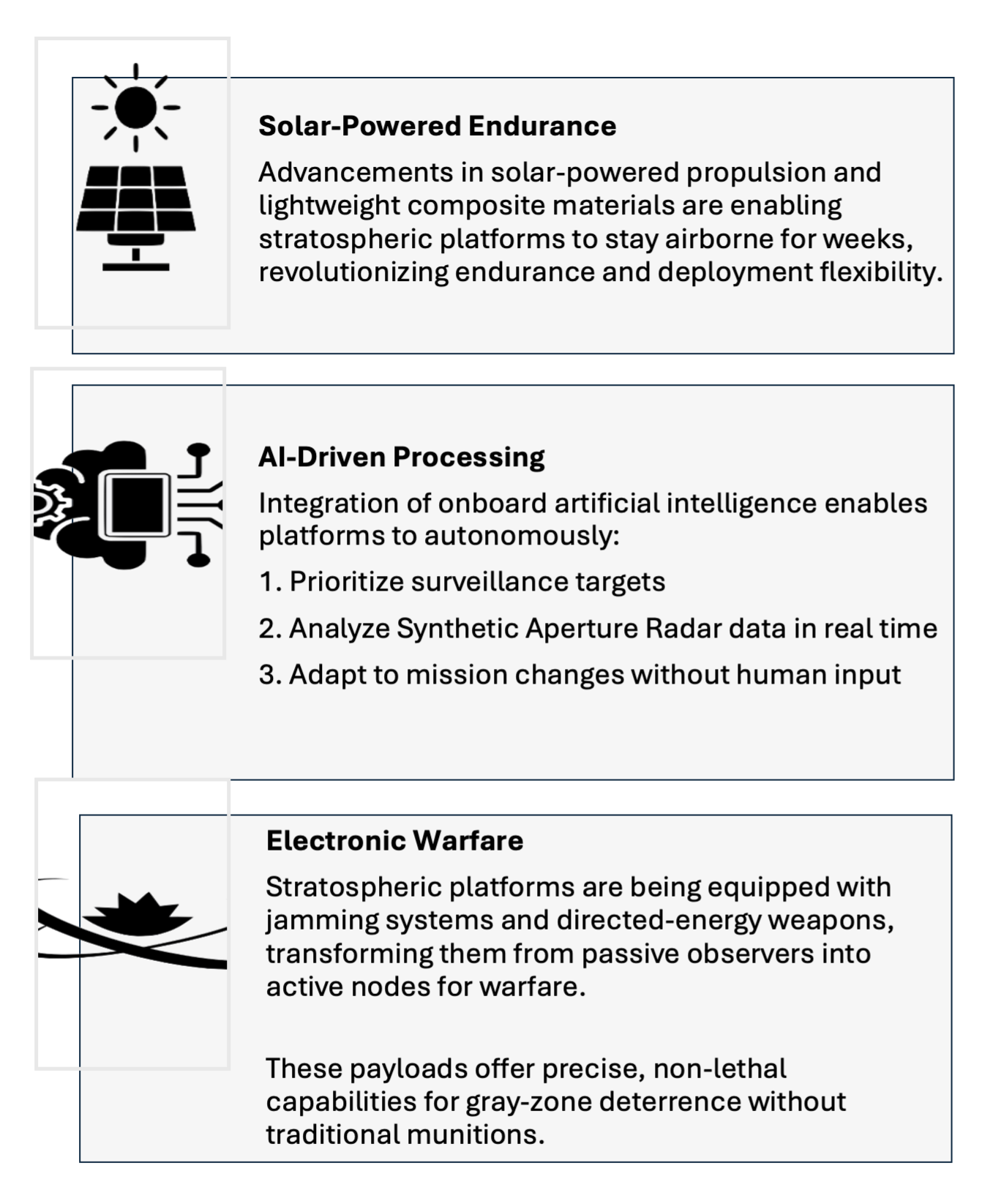The stratosphere has emerged as a new and largely unregulated frontier of military competition. While the militarization of outer space and the proliferation of drone warfare within conventional airspace have received a lot of attention, stratospheric operations remain an underexamined yet evolving domain. The legal boundary between sovereign airspace and the global commons of outer space plays a critical role in modern military strategy, particularly through the deployment of High-Altitude Long-Endurance (HALE) platforms and High-Altitude Platform Systems (HAPS).
Initially dominated by the United States in the 1990s and 2000s, high-altitude operations centered around uncrewed platforms like the RQ-4 Global Hawk, which offered intelligence, surveillance, and reconnaissance (ISR) capabilities across conflict zones in Iraq and Afghanistan.1 These platforms acted as quasi-satellites, operating in a relatively permissive environment where asymmetric threats lacked the ability to contest aerial dominance. However, the strategic apparatus has shifted sharply since the 2010s. China and Russia, recognizing the vulnerabilities exposed by reliance on high-altitude ISR, have aggressively developed anti-access capabilities that can detect and target HALE platforms at high altitudes.2 Compounding this challenge is the rapid integration of artificial intelligence (AI) into defense systems. The third revolution in military affairs, following gunpowder and nuclear weapons, has seen AI-driven technologies transform the speed and precision of battlefield decision-making. In this emerging frontier, uncrewed stratospheric platforms are being equipped not only for passive ISR roles but also for autonomous decision-making, electronic warfare (EW), and offensive support operations.3 The U.S.’s shift to concepts like Joint All-Domain Command and Control (JADC2) and “Mosaic Warfare” reflects a growing need for resilient, distributed, and adaptable sensor networks, in which stratospheric assets play a pivotal role.
This paper will examine how the U.S., China, and Russia are leading the militarization of near space through platforms such as high-altitude balloons, pseudo-satellites, and solar-powered drones. In addition to analyzing the capabilities and deployments of near-space platforms, the paper will assess the legal ambiguities and strategic risks associated with their use, including the risks of misattribution and unauthorized interceptions. Without coherent international governance, the militarization of near-space will continue unchecked, increasing the likelihood of crises, accidents, and potentially catastrophic miscalculations among major powers. Understanding the evolution, current uses, and future trajectories of stratospheric surveillance systems is therefore essential for anticipating the next phase of great power competition.
Strategic Value of Near-Space Surveillance Platforms
The stratosphere has continued to remain a contested domain for surveillance, communications, and military operations. The strategic significance of near-space platforms, particularly high-altitude pseudo-satellites, surveillance balloons, and stratospheric drones, has grown alongside modern geopolitical tensions and technological advancements. Unlike traditional satellites or terrestrial systems, near-space platforms offer unique operational advantages, including persistent coverage, flexibility in deployment, and lower costs, while also raising legal, security, and ethical challenges.4
The shift toward exploiting the stratosphere is primarily driven by its tactical and strategic advantages. High-altitude surveillance systems such as the Raven Aerostar balloons, Airbus’ Zephyr solar gliders, and Stratospheric Platforms’ hydrogen-powered HAPS offer semi-permanent, high-resolution monitoring capabilities at a fraction of the cost of satellite deployments.5 One of the earliest demonstrations of this near-space flexibility came with the U.S. military’s use of the RQ-4 Global Hawk, which operated at high altitudes to deliver persistent ISR coverage.6 Unlike low-earth orbit satellites, which must be launched at considerable financial and technological cost, near-space systems can be deployed rapidly, adjusted mid-mission, and in some cases, recovered and reused. This transformation is emblematic of the third revolution in military affairs, where AI, autonomy, and real-time data fusion are enabling faster and more distributed forms of warfare.7
The stratosphere enables persistent ISR operations without crossing the political thresholds typically associated with space-based assets. This capability is critical to operationalizing JADC2, which relies on rapid, AI-driven data fusion from distributed sensors across multiple domains.8 In May 2025, India successfully conducted the first flight trials of a stratospheric airship platform developed by the Defense Research and Development Organization in Sheopur, Madhya Pradesh.9 Launched to an altitude of 17 kilometers, this airship aims to enhance India’s surveillance capabilities, marking a significant step in expanding near-space ISR operations.10 Mosaic Warfare complements this by envisioning a battlespace composed of numerous small, adaptable ISR and strike elements, like HALE and HAPS platforms that can be dynamically networked and recombined in real time to overwhelm adversaries. These platforms can cover remote or geopolitically sensitive regions without the diplomatic entanglements tied to satellite overflights, making them appealing for states seeking enhanced situational awareness without necessarily provoking formal disputes. This strategic calculus underpins recent deployments by China in the Taiwan Strait, Russia in the Arctic, and the U.S. in the Indo-Pacific, each seeking ISR advantage in contested theaters.11
In 2023, Russia’s Ministry of Defense initiated a stratospheric ISR balloon program under the guise of atmospheric research, repurposing meteorological balloons for persistent surveillance over sensitive zones in the Arctic and Eastern Europe.12 The balloons were equipped with synthetic aperture radar (SAR) and signals intelligence payloads, capable of flying for up to 10 hours at altitudes of 30-40 kilometers.13 These deployments have been particularly active near Kaliningrad and Murmansk, signaling a shift toward routine ISR missions in contested airspaces. The program also underscores Russia’s ambition to develop cost-effective surveillance methods amidst sanctions that limit access to advanced satellite technology.
The February 2023 Chinese surveillance balloon incident, which prompted the U.S. to dispatch an F-22 to shoot it down over South Carolina, highlighted both the strategic surveillance potential of near-space platforms and their capacity to trigger diplomatic crises.14 The balloon’s flight path and sensor payload raised credible concerns about military intelligence collection, exposing critical vulnerabilities in U.S. airspace monitoring. Although China claimed the balloon was for civilian meteorological purposes, its trajectory and payload strongly suggested military surveillance capabilities.15 This incident elevated public awareness of stratospheric surveillance while simultaneously exposing critical gaps in existing airspace and space law, particularly regarding jurisdiction, permissible uses, and acceptable responses to such intrusions.
Technological advancements have made HAPS and similar platforms more viable than in past decades. Innovations in materials science, solar power, hydrogen fuel cells, and lightweight composites have extended flight durations from hours to weeks. In 2022, Airbus’ Zephyr S solar-powered HALE platform set a record with a 64-day continuous flight, showcasing the endurance potential of near-space systems.16 However, the test also revealed persistent challenges, including lithium-sulfur battery degradation and flight instability caused by stratospheric turbulence, which continue to hinder reliable, long-term deployment.17 Private companies are aggressively investing in the sector. Backed by Deutsche Telekom, Stratospheric Platforms Ltd. has raised over US$65.67 million to develop hydrogen-powered HAPS vehicles capable of delivering high-capacity 5G coverage, positioning themselves as low-cost alternatives to satellite constellations.18 These hydrogen fuel-cell platforms diverge from solar-glider HAPS by enabling sustained operations with heavier payloads, including active electronically scanned array 5G transceivers and SAR, enhancing both telecommunications and surveillance capabilities for military and civilian users.19 The commercial sector’s heavy involvement suggests that the militarization of the stratosphere may not proceed solely through traditional state-based procurement but will involve dual-use private technologies, raising regulatory challenges.
This introduces a strategic instability not present with traditional satellites, where anti-satellite weapons (ASAT) are still seen as escalatory due to debris generation and the risk to global space assets. 20 Unlike satellite engagements, which risk global repercussions, the interception of stratospheric systems, such as the U.S. and Canadian shootdowns of unidentified aerial objects in February 2023 and Israel’s 2024 Sky Dew incident, may remain to be perceived as proportionate and politically tolerable actions. Recent cases, including the Hezbollah loitering munition strike on Israel’s Sky Dew system in May 2024, underscore the operational fragility of near-space surveillance platforms when exposed to low-cost, asymmetric threats.21 In May 2024, Hezbollah militants destroyed an Israeli Sky Dew aerostat used for missile defense detection with a loitering munition strike.22 The Sky Dew, designed to detect threats up to 250 kilometers away, was incapacitated by a kamikaze drone, highlighting the vulnerability of such platforms to low-cost, asymmetric attacks.23 Similarly, U.S. and Canadian air forces shot down unidentified objects over Alaska, Yukon, and Lake Huron in early 2024, some of which were later characterized as small metallic balloons.24
Surveillance systems may carry dual-use payloads, such as SARs capable of military targeting or kinetic payloads. The absence of clear international regulations governing their deployment could enable a rapid transition toward weaponization, especially as conventional ASATs, such as ground-launched missiles or directed-energy systems, are integrated into military doctrines.25 States may exploit near-space platforms for ISR operations in ways that are nominally legal but politically provocative or engage in preemptive strikes against them under ambiguous “self-defense” claims. The risk is that near-space militarization will mirror the Cold War dynamics of space, where the absence of binding constraints produced a destabilizing arms race. Near-space platforms are far cheaper, more accessible, and operationally flexible than satellites, making them attractive not only to major powers but also to smaller states and non-state actors.26 This democratization of near-space access may lead to a diffusion of ISR capabilities far beyond traditional military hierarchies, complicating strategic calculations. Moreover, the relative ease with which stratospheric platforms can be intercepted could paradoxically lower the threshold for conflict. While satellites are generally off-limits due to the high escalation risks associated with ASAT strikes, shooting down a balloon or HAPS may be seen as a proportionate and limited response, making near-space engagements more frequent and more dangerous in future crises.
The increasing reliance on private-sector HAPS development raises critical questions about sovereign control and national security. As commercial firms like Airbus, Aerostar, and Stratxx lead innovation, governments face mounting challenges in regulating access, ensuring data security, and compelling the sharing of intelligence. The absence of a formal policy on dual-use ISR assets could lead to regulatory gaps and fragmented crisis response coordination in the event of near-space escalation.27 Near-space surveillance platforms offer clear strategic value, but they also introduce significant risks, both technical and political. Near-space platforms offer extraordinary strategic advantages at relatively low cost, incentivizing their rapid proliferation among major and emerging powers alike. Yet they also introduce newer escalation risks and opportunities for gray-zone coercion. If current trends continue, the stratosphere may evolve into a domain where surveillance, disruption, and selective engagement become normalized features of strategic competition. Interceptions of balloons and HAPS could shift from rare incidents to routine acts of military signaling.
Figure 1: Global Timeline of Stratospheric ISR Milestones and Incidents (2022-2025)

Source: Author’s creation using Visme
Risks and Legal Gray Zones
The rapid militarization of the stratosphere introduces risks that current legal and strategic frameworks are ill-equipped to manage. As near-space platforms increasingly blend surveillance, communications, and dual-use functions, they occupy an unstable legal and operational gray zone that threatens to destabilize international security. The lack of clearly defined boundaries, both in law and operational practice, brings the potential for miscalculation, escalation, and conflict. The deployment of HAPS for communications or surveillance depends on regulatory approval across multiple jurisdictions, which remain underdeveloped.28 Furthermore, durability, bandwidth limitations, and susceptibility to atmospheric disturbances complicate their operational reliability compared to satellites. While near-space platforms currently serve as niche ISR and telecom supplements, their potential to displace traditional satellite functions at scale remains unproven, given their susceptibility to atmospheric disruption, limited bandwidth, and inconsistent jurisdictional oversight.29
The first legal ambiguity lies in the question of where sovereign airspace ends and outer space begins. Under the 1944 Chicago Convention, states maintain complete sovereignty over the airspace above their territory.30 The Kármán Line at 100 kilometers has been informally accepted as the boundary to space, but near-space platforms operate between 20 and 50 kilometers, well below this threshold yet well above conventional aviation altitudes.31 This creates a paradox in which near-space platforms are subject to national airspace laws, but their strategic functions resemble those of satellites. The lack of a codified international legal framework regulating stratospheric surveillance enables states to invoke plausible deniability, often framing military reconnaissance operations as meteorological or scientific missions to avoid diplomatic fallout.
Figure 2: Legal & Operational Gray Zone Map

Source: Author’s creation using Canva
States may struggle to control the operational use of commercial near-space assets during crises. Companies seeking profit maximization may resist government demands to restrict services, especially when operating across multiple jurisdictions. Alternatively, governments could forcibly nationalize commercial platforms during conflicts, raising issues of ownership, liability, and the militarization of civilian technology. Moreover, adversaries may not differentiate between civilian and military stratospheric platforms, targeting commercial assets under the assumption of dual-use capabilities.32 The integration of commercial platforms into military operations, exemplified by SpaceX’s Starlink providing battlefield internet services to Ukrainian forces, underscores how civilian near-space technologies can become active participants.33
The problem is compounded by the potential for EW against these assets. Russia has demonstrated advanced EW capabilities, employing them effectively in conflicts such as in Ukraine and Syria.34 These tactics include jamming and disrupting communication and navigation systems, posing significant threats to near-space platforms. As demonstrated by Russia’s efforts to jam or disrupt Western surveillance platforms near its borders, electronic attacks offer a low-cost, low-visibility method for neutralizing near-space systems without crossing the political threshold of kinetic action.35 Due to their limited structural defenses and predictable flight profiles, stratospheric platforms represent ideal targets in gray-zone conflicts. Their operational value for ISR makes them strategically significant, yet their vulnerability to conventional air-to-air or surface-to-air weapons allows adversaries to engage them without triggering the escalation typically associated with satellite strikes.36
One of the most serious long-term risks is the absence of binding international norms governing the military use of the stratosphere. Although the Outer Space Treaty limits the deployment of weapons of mass destruction in outer space, no comparable legal instrument addresses conventional weaponization of near-space assets. Efforts to negotiate broader treaties, such as Russia and China’s proposed Prevention of the Placement of Weapons in Outer Space Treaty (PPWT), have repeatedly stalled due to distrust among major powers. The PPWT proposed by China and Russia in 2008 has seen little advancement.37 Critics argue that the treaty lacks verification mechanisms and does not address ground-based ASAT, leading to skepticism among other nations.38 This normative vacuum incentivizes preemptive behavior. States may feel compelled to destroy surveillance platforms deemed hostile before they can gather critical intelligence, citing self-defense.
The militarization of the stratosphere introduces new vulnerabilities. Near-space platforms, despite their altitude advantage over aircraft, are relatively slow-moving, unarmored, and visible to radar.39 More concerning is the emerging trend of states deploying EW capabilities to disrupt near-space platforms without direct action. These incidents demonstrate the rising use of electromagnetic disruption and cyber interference, favored for their deniability and strategic ambiguity over direct kinetic action in contesting surveillance assets.40 Given the relative fragility of HAPS and balloons compared to hardened military satellites, states may view them as easy, low-risk targets during crises, potentially escalating conflicts through gray-zone tactics. Furthermore, the blurred boundary between militarization and weaponization of near-space platforms mirrors broader trends in outer space security.
Stratospheric ISR platforms erode traditional notions of national sovereignty by enabling persistent, detailed surveillance without the technical or political barriers associated with satellite overflight. Chinese surveillance balloons tracked over Taiwan in late 2023 and early 2024,41 and Russia’s newly announced stratospheric ISR balloon program illustrate how near-space assets are already integral to regional military strategies. Unlike satellites in legal outer space, stratospheric platforms operating in national airspace technically require permission.42 China deployed over 100 balloons across the Taiwan Strait, many entering Taiwanese airspace.43 These actions, interpreted as gray-zone warfare, aimed to exert psychological pressure without direct military confrontation.44 Taiwan’s limited public responses to Chinese high-altitude balloons illustrate the strategic restraint exercised by smaller states in order to avoid escalation, despite ongoing airspace violations.
Over time, persistent near-space surveillance could normalize low-level violations of sovereignty, particularly against weaker states lacking effective air defense systems. This trend mirrors historical patterns of great powers conducting reconnaissance flights during the Cold War under the guise of civilian missions, undermining the integrity of international norms.
Future of Stratospheric Militarization
The evolution of stratospheric militarization challenges existing concepts of sovereignty, conflict management, and technological control. The global stratospheric flying drone market is projected to experience significant growth between 2025 and 2033, driven by advancements in lightweight materials, solar-powered propulsion systems, and autonomous navigation technologies.45 The global defense communication intelligence market is projected to grow from US$23.13 billion in 2025 to approximately US$40.53 billion by 2034, reflecting a compound annual growth rate (CAGR) of 6.43%.46 This growth underscores the increasing investment in stratospheric ISR and communication platforms. Yet this rapid technological expansion is outpacing the development of international regulatory mechanisms, creating a vacuum that adversarial states may exploit to test geopolitical red lines.
The strategic utility of stratospheric platforms is evident as nations invest in HALE drones and stratospheric balloons for military applications. For instance, Iran’s introduction of the Shahed-147 HALE drone, capable of operating at altitudes up to 60,000 feet and equipped with SAR, underscores the shift toward persistent, high-altitude surveillance capabilities.47 Similarly, Russia tested a high-altitude surveillance drone over the Barents Sea, signaling Moscow’s intent to expand ISR capabilities into near-space zones beyond conventional radar coverage.48 These developments highlight a trend where military applications are rapidly overtaking civilian use cases in scale and priority, emphasizing the need for international regulatory frameworks to manage the evolving dynamics of stratospheric militarization.
A key technological addition will be the integration of AI-driven onboard processing, allowing stratospheric platforms to autonomously prioritize surveillance targets, adapt to evolving conditions, and conduct preliminary analysis before downlinking data. Advancements in the onboard processing of SAR data are enhancing the efficiency and real-time capabilities of ISR platforms. These improvements are critical for timely decision-making in dynamic operational environments. Such capabilities reflect the doctrinal shift underpinning the third military revolution, as decision-making cycles are shortened. The integration of onboard AI analytics is projected to reduce ISR data processing,49 but it also risks blurring attribution in contested environments, especially when autonomous platforms operate with limited human intervention. Another foreseeable development is the adaptation of stratospheric platforms to carry jamming equipment. Directed-energy weapons (DEWs), such as high-energy lasers and radio-frequency systems, are being developed for deployment on various platforms, including high-altitude unmanned systems.50 DEWs offer precise targeting capabilities without the need for traditional munitions. While armament on solar-powered platforms remains unlikely due to payload constraints, non-kinetic capabilities involving EW are within technological reach. This could transform HALE platforms from passive collectors to active participants in military engagements, especially in gray-zone conflicts. The dual-use nature of stratospheric technologies, highlighted using civilian imaging platforms for military targeting in Ukraine, suggests that strict separation between civilian and military roles will be harder to sustain.51 Ukraine has leveraged AI-driven unmanned systems to enhance combat effectiveness, demonstrating the dual-use potential of civilian technologies in military applications.52 Future conflicts may see commercial HALE systems repurposed for real-time targeting support, blurring legal and ethical lines.
Near-space ISR platforms are poised to redefine strategic surveillance by offering persistent, high-altitude coverage with unprecedented endurance. This endurance allows for prolonged monitoring of target areas, surpassing traditional satellite limitations. Unlike satellites with fixed orbits, HALE vehicles like the Zephyr can adjust their positioning in real time, providing adaptable surveillance tailored to dynamic battlefield conditions.53 Such flexibility is crucial for modern military operations, where real-time intelligence can significantly influence outcomes. The strategic advantage of these platforms lies in their ability to operate in near space, offering a unique vantage point for ISR missions. Their prolonged presence over areas of interest can lead to the normalization of overflights, potentially challenging existing notions of airspace sovereignty. The integration of advanced technologies such as AI-driven analytics and autonomous navigation systems will further enhance the capabilities of near-space ISR platforms. These advancements will enable more efficient data processing and decision-making, reducing the latency between intelligence gathering and actionable insights.
Figure 3: Technological & Strategic Utility

Source: Author’s creation using Microsoft SmartArt, adopting visuals from The Noun Project
The absence of a universally accepted legal boundary between sovereign airspace and outer space remains a foundational challenge. Without a fixed demarcation, states have wide latitude to interpret violations according to their interests. These actions were perceived as part of a gray-zone warfare strategy aimed at psychological intimidation without direct military confrontation. Efforts to establish new international frameworks for stratospheric activity face significant obstacles. Major powers benefit disproportionately from exploiting legal ambiguities, making them unlikely sponsors of restrictive regimes. Even if agreements are reached, verifying payloads, missions, or compliance would be difficult given the dual-use nature of stratospheric platforms.
The more plausible near-term scenario is the development of fragmented, regional norms. Alliance blocs such as NATO, the Indo-Pacific Quad, or the Shanghai Cooperation Organization could enhance regulated stratospheric activities within their spheres of influence. Private sector actors are becoming central players in the development and operation of near-space assets. In October 2024, Mira Aerospace announced the development of two advanced payloads for deployment on their HAPS, offering high-resolution Earth observation data and reliable telecommunications capabilities.54 Unlike the early space age, where state agencies dominated aerospace activities, the stratospheric era is shaped by hybrid public-private ecosystems.
The resilience and redundancy of near-space systems remain largely untested at scale, raising concerns about their vulnerability in future high-intensity conflicts. The utilization of EW tactics, as evidenced by Ukraine’s deployment of the portable anti-drone system EDM4S, highlights the susceptibility of HALE platforms to jamming and signal disruption.55 These developments underscore the need for countermeasures that ensure the operational integrity of stratospheric assets. Moreover, the proliferation of loitering munitions, which combine surveillance and precision strike capabilities, presents a dual threat to HALE systems by enabling both detection and targeted attacks. As these technologies become more accessible, the strategic reliance on HALE platforms without adequate protective measures could lead to significant operational risks. The future of stratospheric militarization will depend on the development of resilient systems capable of withstanding EW threats and the establishment of protocols to mitigate the risks associated with emerging offensive technologies.
Conclusion
The militarization of the stratosphere marks a pivotal inflection point in global security dynamics, exposing critical gaps in legal regimes, operational doctrines, and international norms. As near-space platforms proliferate, they are reshaping strategic calculations by offering persistent, flexible, and cost-effective ISR capabilities that transcend the traditional boundaries of air and space law. However, the accessibility, dual-use nature, and interceptability of stratospheric systems introduce new pathways for escalation that the current international security architecture is poorly equipped to manage.
The lack of binding legal frameworks governing near-space has created a permissive environment in which both state and non-state actors can leverage these platforms for intelligence gathering, gray-zone coercion, and potentially preemptive military action. Operating in a legal and operational gray zone, these assets blur the lines between surveillance and provocation, thereby increasing the potential for miscalculation and strategic ambiguity. As great powers integrate these platforms into hybrid warfare doctrines, routine interceptions, EW, and proxy contests will become more likely features of future crises. Compounding this volatility is the rapid commercialization of stratospheric technologies. Private firms, motivated by commercial imperatives, now operate platforms that can be easily repurposed for military objectives. This convergence of public and private domains complicates attribution, heightens legal uncertainty, and reduces state control in crisis scenarios. The risk is that commercial ISR platforms may become inadvertent actors in geopolitical flashpoints, drawing states into further escalation.
Establishing legal clarity on the boundary between sovereign airspace and outer space, implementing confidence-building mechanisms, and strengthening the resilience and traceability of stratospheric systems are critical priorities. These steps are essential to prevent near-space from replicating the legal ambiguity and strategic instability that now characterize cyberspace and low-earth orbit. The course set by current policy decisions will shape whether the stratosphere remains a contested frontier or transitions into a regulated domain of strategic restraint.
References
[1] U.S. Air Force, “RQ-4 Global Hawk,” Last modified October 2014, https://www.af.mil/About-Us/Fact-Sheets/Display/Article/104516/rq-4-global-hawk/.
[2] Syed Muhammad Irteza Imam and Sufian Ullah, “Anti-Access Area Denial Capabilities: Implications for Strategic Stability,” Journal of Security and Strategic Analyses 6, no. 1 (2020): 17–42, https://thesvi.org/wp-content/uploads/2020/09/JSSA-Vol-VI-no-1-17-42.pdf.
[3] Daljit Singh, “Electronic Warfare: Changing Operational Concepts,” Air Power Journal 16, no. 2 (Summer 2021): 43–50, https://capsindia.org/wp-content/uploads/2021/12/Daljit-Singh.pdf.
[4] Hongshan Liu et al, “Near-Space Communications: The Last Piece of 6G Space–Air–Ground–Sea Integrated Network Puzzle,” Space: Science & Technology 4 (August 12, 2024), Article ID 0176, https://doi.org/10.34133/space.0176.
[5] Flavio Araripe D’Oliveira, Francisco Cristovão Lourenço De Melo, and Tessaleno Campos Devezas, “High-Altitude Platforms – Present Situation and Technology Trends,” Journal of Aerospace Technology and Management 8, no. 3 (2016): 249–62, https://doi.org/10.5028/jatm.v8i3.699.
[6] “Global Hawk: Vigilance for a Changing World,” Northrop Grumman, accessed May 13, 2025, https://www.northropgrumman.com/what-we-do/air/global-hawk.
[7] Éléonore Daxhelet, Artificial Intelligence and the Future of Warfare, supervised by Ginevra Bertamini, Food For Thought Paper (Brussels: Finabel – The European Land Force Commanders Organisation, 2023), https://finabel.org/wp-content/uploads/2024/07/FFT-AI-and-the-future-of-warfare-ED.pdf.
[8] John R Hoehn, Joint All-Domain Command and Control (JADC2), IF11493, Washington, DC: Congressional Research Service, January 21, 2022, https://crsreports.congress.gov/product/pdf/IF/IF11493.
[9] Ministry of Defence, “DRDO Conducts Maiden Flight-Trials of Stratospheric Airship Platform,” Press Information Bureau, Government of India, May 3, 2025, https://www.pib.gov.in/PressReleaseIframePage.aspx?PRID=2126640.
[10] Ibid.
[11] J. B. Barranco, Taiwan: The Key to Containing China in the Indo-Pacific: A Strategy of Deterrence to Maintain the US-Led, Rules-Based Global System (Washington, DC: Atlantic Council, November 2022), https://www.atlanticcouncil.org/wp-content/uploads/2022/11/Taiwan_the-key-to-containing-China-in-the-Indo-Pacific.pdf.
[12] “Exclusive: Russia Develops Long-Duration Stratospheric Balloon Technology for Military and Spy Missions,” Army Recognition, December 3, 2024, https://armyrecognition.com/focus-analysis-conflicts/army/defence-security-industry-technology/exclusive-russia-develops-long-duration-stratospheric-balloon-technology-for-military-and-spy-missions.
[13] Ibid.
[14] Jim Garamone, “F-22 Safely Shoots Down Chinese Spy Balloon Off South Carolina Coast,” U.S. Department of Defense, February 4, 2023, https://www.defense.gov/News/News-Stories/Article/article/3288543/f-22-safely-shoots-down-chinese-spy-balloon-off-south-carolina-coast/.
[15] Kathleen Magramo, Andrew Raine, Matt Meyer, Adrienne Vogt, and Tori B. Powell, “February 4, 2023 US Shoots Down Chinese Spy Balloon off East Coast,” CNN, February 5, 2023, https://edition.cnn.com/politics/live-news/suspected-chinese-balloon-over-us-02-04-23.
[16] Yasim J. Hasan, Mathias S. Roeser, Martin Hepperle, Steffen Niemann, Arne Voß, Vega Handojo, and Christian Weiser, “Flight Mechanical Analysis of a Solar-Powered High-Altitude Platform,” CEAS Aeronautical Journal 14 (2023): 201–223, https://doi.org/10.1007/s13272-022-00621-2.
[17] Joseph Flaig, “Zephyr Drone’s Unfortunate End Little Cause for Concern after Record-Breaking 64-Day Flight,” Institution of Mechanical Engineers, December 1, 2022. https://www.imeche.org/news/news-article/zephyr-drone’s-unfortunate-end-little-cause-for-concern-after-record-breaking-64-day-flight.
[18] Luke Hurst, “Could Autonomous Hydrogen-Powered Aircraft Be the Answer to Connecting the World to the Internet?,” Euronews, March 7, 2023. https://www.euronews.com/next/2023/03/07/could-autonomous-hydrogen-powered-aircraft-be-the-answer-to-connecting-the-world-to-the-in.
[19] Tim Robinson, “Hydrogen-Powered UAV to Fly ‘Beast’ of the World’s Biggest Airborne 5G Antenna,” Royal Aeronautical Society, October 23, 2020, https://www.aerosociety.com/news/hydrogen-powered-uav-to-fly-beast-of-the-worlds-biggest-airborne-5g-antenna/.
[20] United Nations General Assembly, “Destructive Anti-satellite Weapons,” Working Paper Submitted by Brazil, A/AC.294/2023/WP.13, Geneva: Open-ended Working Group on Reducing Space Threats, February 6, 2023, https://docs.un.org/en/A/AC.294/2023/WP.13.
[21] Aviation Safety Network. “High Availability Aerostat System Sky Dew – 15 May 2024,” ASN Aviation Safety WikiBase, Last modified May 19, 2024, Accessed May 13, 2025, https://asn.flightsafety.org/wikibase/388087.
[22] Ibid.
[23] Thomas Harding and Nada Homsi, “Hezbollah ‘Blinds’ Israeli Defences with Drone Strike on Sky Dew Airship,” The National, May 17, 2024, https://www.thenationalnews.com/news/mena/2024/05/17/hezbollah-blinds-israeli-defences-with-drone-strike-on-sky-dew-airship/.
[24] David Cenciotti, “First Image of Unidentified Object Shot Down By F-22 Over Canada In 2023 Emerges,” The Aviationist, September 25, 2024, https://theaviationist.com/2024/09/25/image-of-unidentified-object-shot-down-over-canada/.
[25] U.S. Congress, Office of Technology Assessment, Anti-Satellite Weapons, Countermeasures, and Arms Control. OTA-ISC-281, Washington, DC: U.S. Government Printing Office, September 1985, https://aerospace.csis.org/wp-content/uploads/2018/09/OTA-Report-on-ASAT-Weapons-and-Countermeasures-1985.pdf.
[26] W. Stone Holden, “High-Altitude Pseudo-Satellites Are Ready for Launch,” Proceedings 149, no. 2 (February 2023), U.S. Naval Institute, https://www.usni.org/magazines/proceedings/2023/february/high-altitude-pseudo-satellites-are-ready-launch.
[27] U.S. Government Accountability Office, “Intelligence, Surveillance, and Reconnaissance: Actions Are Needed to Increase Integration and Efficiencies of DOD’s ISR Enterprise,” Report to Congressional Committees, GAO-11-465, June 2011, https://www.gao.gov/assets/gao-11-465.pdf.
[28] Steve Chukwuebuka Arum, David Grace, and Paul Daniel Mitchell, “A Review of Wireless Communication Using High-Altitude Platforms for Extended Coverage and Capacity,” Computer Communications 157 (May 2020): 232–256, https://doi.org/10.1016/j.comcom.2020.04.020.
[29] Gunes Karabulut Kurt, Mohammad G. Khoshkholgh, Safwan Alfattani, Ahmed Ibrahim, Tasneem S. J. Darwish, Md Sahabul Alam, Halim Yanikomeroglu, and Abbas Yongacoglu, “A Vision and Framework for the High Altitude Platform Station (HAPS) Networks of the Future,” IEEE Communications Surveys & Tutorials 23, no. 2 (March 2021): 1091–1138, https://doi.org/10.1109/COMST.2021.3066905.
[30] International Civil Aviation Organization, “Convention on International Civil Aviation, signed at Chicago on 7 December 1944,” 2006, https://www.icao.int/publications/Documents/7300_orig.pdf.
[31] Paul Stephen Dempsey and Maria Manoli, Suborbital Flights and the Delimitation of Air Space vis-à-vis Outer Space: Functionalism, Spatialism and State Sovereignty, United Nations Committee on the Peaceful Uses of Outer Space, Legal Subcommittee, Fifty-seventh session, 9–20 April 2018, https://www.unoosa.org/res/oosadoc/data/documents/2018/aac_105c_22018crp/aac_105c_22018crp_9_0_html/AC105_C2_2018_CRP09E.pdf.
[32] David A. Koplow, “Reverse Distinction: A U.S. Violation of the Law of Armed Conflict in Space,” Harvard National Security Journal 13, no. 1 (2022): 25–114, https://harvardnsj.org/wp-content/uploads/2022/01/HNSJ-Vol-13-Koplow-ReverseDistinction.pdf.
[33] Nick Paton Walsh, Alex Marquardt, Florence Davey-Attlee, and Kosta Gak, “Ukraine Relies on Starlink for Its Drone War. Russia Appears to Be Bypassing Sanctions to Use the Devices Too,” CNN, last updated March 26, 2024, https://edition.cnn.com/2024/03/25/europe/ukraine-starlink-drones-russia-intl-cmd.
[34] Duncan McCrory, “Electronic Warfare in Ukraine: Preliminary Lessons for NATO Air Power Capability Development,” The Journal of the JAPCC, Edition 36, Joint Air Power Competence Centre, October 2023, https://www.japcc.org/articles/electronic-warfare-in-ukraine/.
[35] Daniela Pistoia, “Detecting and Neutralizing Mini-Drones: Sensors and Effectors against an Asymmetric Threat,” The Journal of the JAPCC, Edition 25, Joint Air Power Competence Centre, March 2018, https://www.japcc.org/articles/detecting-and-neutralizing-mini-drones/.
[36] Paul van Hooft and Lotje Boswinkel, “Surviving the Deadly Skies: Integrated Air and Missile Defence 2021–2035,” The Hague Centre for Strategic Studies, November 2021, https://hcss.nl/wp-content/uploads/2021/12/Integrated-Air-and-Missile-Defense-HCSS-Dec-2021.pdf.
[37] Mia Gandenberger, “Russia and China Table New Draft Treaty to Prevent Weapons in Space,” Reaching Critical Will, Women’s International League for Peace and Freedom, June 10, 2014, https://www.reachingcriticalwill.org/disarmament-fora/cd/2014/cd-reports/8908-russia-and-china-table-new-draft-treaty-to-prevent-weapons-in-space.
[38] Ibid.
[39] J. Gordon Leishman, Introduction to Aerospace Flight Vehicles (Daytona Beach, FL: Eagle Pubs, Embry‑Riddle Aeronautical University, 2022–2025), https://eaglepubs.erau.edu/introductiontoaerospaceflightvehicles/chapter/lth/.
[40] Vincent L. DeFabo, “Rethinking Cyberspace Operations: Widespread Electromagnetic Jamming by States Indicates Cyber Interference Is Not a Use of Force,” Journal of Air Law and Commerce 86, no. 2 (2021): 219–276, https://scholar.smu.edu/jalc/vol86/iss2/3.
[41] Dharvi Vaid, “Taiwan Detects Airplanes, 6 Balloons from China near Island,” DW (Deutsche Welle), February 7, 2025, https://www.dw.com/en/taiwan-detects-airplanes-6-balloons-from-china-near-island/a-71534531.
[42] Paul Stephen Dempsey and Maria Manoli, Suborbital Flights, 2025.
[43] Jackie Gu and Yimou Lee, “Tracking China’s ‘Grey Zone’ Balloon Flights over Taiwan,” Reuters, May 17, 2024, https://www.reuters.com/graphics/TAIWAN-CHINA/BALLOONS/lbpglrgwwvq/.
[44] Ibid.
[45] Global Stratospheric Flying Drone Market Report: Market Size, Share, Trends & Growth Analysis Report Segmented by Type, Application, and Regions (2025–2033), Value Market Research, February 2025, https://www.valuemarketresearch.com/report/stratospheric-flying-drone-market.
[46] “Defense Communication Intelligence Market Size, Share and Trends 2025 to 2034,” Precedence Research, last modified February 19, 2025, https://www.precedenceresearch.com/defense-communication-intelligence-market#:~:text=The%20global%20defense%20communication%20intelligence,2024%20as%20the%20base%20year.
[47] “Iran Introduces High Altitude Long Endurance (HALE) Drone ‘Shaed-147’,” Defence Security Asia, November 22, 2023, https://defencesecurityasia.com/en/iran-introduces-high-altitude-long-endurance-hale-drone-shaed-147/.
[48] Tom Porter, “NATO Countries Are Racing Russia to Develop Drones Capable of Operating in the Arctic,” Business Insider, May 9, 2025, https://www.businessinsider.com/nato-allies-race-russia-develop-arctic-drones-weather-cold-china-2025-5.
[49] “AI Impact Analysis on the LEO Satellite Industry,” MarketsandMarkets, last modified April 23, 2025, https://www.marketsandmarkets.com/ResearchInsight/ai-impact-analysis-leo-satellite-industry.asp.
[50] James Black, “Directed Energy: The Focus on Laser Weapons Intensifies,” RAND Corporation, January 25, 2024, https://www.rand.org/pubs/commentary/2024/01/directed-energy-the-focus-on-laser-weapons-intensifies.html.
[51] Amaury Heintz, “The War in Ukraine – Do Dual Use Technologies Challenge the Principle of Distinction?” The Pardee Atlas Journal of Global Affairs, Boston University, 2024, https://sites.bu.edu/pardeeatlas/the-pardee-atlas-conference/2024-conference-abstracts/the-war-in-ukraine-do-dual-use-technologies-challenge-the-principle-of-distinction/.
[52] Kateryna Bondar, Ukraine’s Future Vision and Current Capabilities for Waging AI-Enabled Autonomous Warfare (Washington, DC: Center for Strategic and International Studies, March 6, 2025), https://www.csis.org/analysis/ukraines-future-vision-and-current-capabilities-waging-ai-enabled-autonomous-warfare.
[53] Richard Gardner, “Staying Up: Ultra Long Endurance UAVs,” Aerospace International, November 5, 2010, Royal Aeronautical Society, https://www.aerosociety.com/news/staying-up-ultra-long-endurance-uavs/.
[54] “Mira Aerospace Announces Two Payloads for Stratospheric Deployment,” Emirates News Agency (WAM), October 24, 2024, https://www.wam.ae/article/b5uex02-mira-aerospace-announces-two-payloads-for.
[55] Ethan Walton, “Here’s the Counter-Drone Platforms Now Deployed in Ukraine,” C4ISRNet, November 21, 2023, https://www.c4isrnet.com/opinion/2023/11/21/heres-the-counter-drone-platforms-now-deployed-in-ukraine/.








